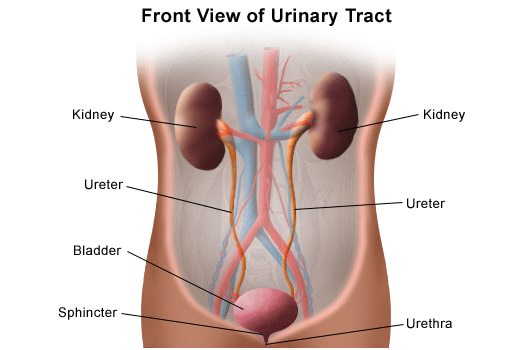
URINARY SYSTEM (Renal System)
FUNCTION:
- Regulate blood volume and composition (e.g. sodium, potassium and calcium)
- Regulate blood pressure.
- Regulate pH homeostasis of the blood.
- Contributes to the production of red blood cells by the kidney.
- Helps synthesize calcitrol the (active form of Vitamin D).
Introduction to the urinary system
The urinary system consists of all the organs involved in the formation and release of urine. It includes the kidneys, ureters, bladder and urethra.
The kidneys are bean-shaped organs which help the body produce urine to get rid of unwanted waste substances. When urine is formed, tubes called ureters transport it to the urinary bladder, where it is stored and excreted via the urethra. The kidneys are also important in controlling our blood pressureand producing red blood cells.
Components of the urinary system
Kidneys and ureters
The kidneys are large, bean-shaped organs towards the back of the abdomen (belly). They lie behind a protective sheet of tissue within the abdomen. The kidneys perform many vital functions which are important in everyday life. For example, they help us get rid of waste products by making urine and excreting it from the body. A special system of tubes within the kidneys allow substances such as sodium (salt) and chloride to be filtered.
The kidneys regulate the amount of water in the body. Humans produce about 1.5 litres of urine a day. However, if we drink more water, we may produce more urine. On hot days, if we get dehydrated and sweat more, we may produce less urine. This is why it’s very important to drink lots of water on hot summer days.
The kidneys also produce renin (a hormone important in regulating blood pressure) and erythropoietin(helps produce red blood cells).
Located in the lower part of our bellies, the right kidney is slightly lower in position than the left, allowing room for the liver. The kidneys are reddish brown in colour and measure about 10 cm in length, 5 cm width and 2.5 cm thick. On the side of the kidney with the smaller curve is an opening called the hilum, where blood vessels, nerves, and the ureters enter the kidney. On one end of the ureters is a funnel-shaped expansion, called the renal pelvis, where urine collects. The ureters carry urine to the bladder; they are 25–30 cm long tubes lined with smooth muscle. The muscular tissue helps force urine downwards. The ureters enter the bladder at an angle, so urine doesn’t flow up the wrong way.
The kidney can be divided into two distinct regions. There is an outer red-brown part (cortex) and inner lighter coloured part (medulla). The cortex is made up of special units called corpuscles, nephrons, and a system of straight and curvy collecting tubules supplied by many blood vessels. In the outer part of the kidney, there are many nephrons which act as filtering units. Each nephron is supplied by a ball of small blood vessels, called glomeruli. A diagram of a single glomerulus is seen below. Blood is filtered through the small blood vessels to produce a mixture that is the precursor of urine. This mixture then passes through more tubules, where water, salt and nutrients are reabsorbed.

The inner part of the kidney (the medulla) is a continuation of the specialized nephrons in the kidney. A small blood vessel network called the vasa recta supplies the medulla. Each kidney is supplied by the renal arteries, which give off many smaller branches to the surrounding parts of the kidneys. Renal veins drain the kidney.
Bladder
The bladder is a pyramid-shaped organ which sits in the pelvis (the bony structure which helps form the hips). The main function of the bladder is to store urine and, under the appropriate signals, release it into a tube which carries the urine out of the body. Normally, the bladder can hold up to 500 mL of urine. The bladder has three openings: two for the ureters and one for the urethra (tube carrying urine out of the body).
The bladder consists of smooth muscles. The main muscle of the bladder is called the detrusor muscle. Muscle fibres around the opening of the urethra forms a ring-like muscle that controls the passage of urine. When we want to urinate, stretch receptors in the bladder are activated, which send signals to our brain and tell us that the bladder is full. The ring-like muscle relaxes and the detrusor muscle contracts, allowing urine to flow.
The blood supply of the bladder is from many blood vessels. Some of these blood vessels are named: the vesical arteries, the obturator, uterine, gluteal and vaginal arteries. In females, a venous network drains blood from the bladder arteries into the internal iliac vein. Nervous control of the bladder involves centres located in the brain and spinal cord.
Urethra
The male urethra is 18–20 cm long, running from the bladder to the tip of the penis. The male urethra is supplied by the inferior vesical and middle rectal arteries. The veins follow these blood vessels. The nerve supply is via the pudendal nerve.
The female urethra is 4–6 cm long and 6 mm wide. It is a tube running from the bladder neck and opening into an external hole located at the top of the vaginal opening. As the female urethra is shorter than the male urethra, it is more likely to get infections from bacteria in the vagina. The female urethra is supplied by the internal pudendal and vaginal arteries.
Reference:
https://www.google.com.ph/search?rlz=1C1CHBD_enPH815PH818&q=urinary+system+organs+and+functions&sa=X&ved=2ahUKEwjNmpvapPneAhWVc3AKHa6ZA2cQ1QIoBXoECAQQBg
https://www.google.com.ph/search?rlz=1C1CHBD_enPH815PH818&q=urinary+system+organs+and+functions&sa=X&ved=2ahUKEwjNmpvapPneAhWVc3AKHa6ZA2cQ1QIoBXoECAQQBg
https://www.myvmc.com/anatomy/urinary-system-renal-system/
https://www.google.com.ph/search?q=urinary+system&rlz=1C1CHBD_enPH815PH818&source=lnms&tbm=isch&sa=X&ved=0ahUKEwjNmpvapPneAhWVc3AKHa6ZA2cQ_AUIDigB&biw=1366&bih=657#imgrc=aBoXo72YRTyGHM:
No comments:
Post a Comment